
Browse an alphabetical list of photographs. These historical images portray people, places, and events before, during, and after World War II and the Holocaust.
<< Previous | Displaying results 201-225 of 232 for "Photo" | Next >>
A streetcar decorated with swastikas passes billboards displaying Hitler's face. The billboards urge Austrians to vote "Ja" (Yes) in the upcoming plebiscite on the German annexation of Austria. Vienna, Austria, April 1938.
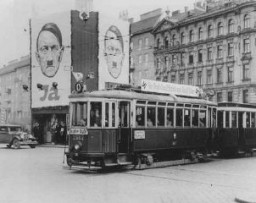
At a ceremony during the 1936 Olympic Games, German spectators spell out the phrase, directed at Adolf Hitler, "Wir gehoeren Dir" [We belong to you]. Berlin, Germany, August 1936.

In this Nazi propaganda picture, young German children are shown eating a meal. The original caption reads: "Everything for the healthy child." Photo dated 1933–1943.
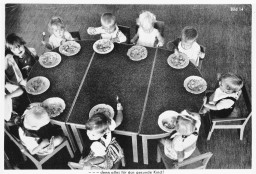
Photograph with the caption: "...because God cannot want the sick and ailing to reproduce." This image originates from a film, produced by the Reich Propaganda Ministry, that aimed through propaganda to develop public sympathy for the Nazi Euthanasia Program.
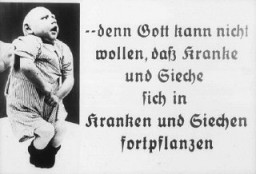
Propaganda Minister Joseph Goebbels (at podium) praises students and members of the SA for their efforts to destroy books deemed "un-German" during the book burning at Berlin's Opernplatz (opera square). Germany, May 10, 1933.

A scene staged by the Nazis for the International Red Cross inspection of the Theresienstadt ghetto. The people are probably watching a soccer match. Czechoslovakia, June 23, 1944.
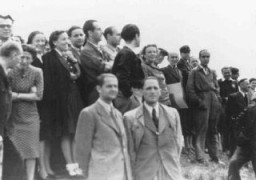
A scene staged by the Nazis for an International Red Cross inspection of the Theresienstadt ghetto. Czechoslovakia, June 23, 1944.
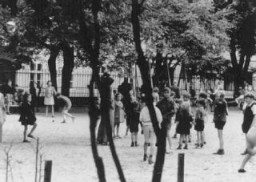
Propaganda slide which contrasts a person of mixed race (left) with a healthy "Aryan" youth (right).
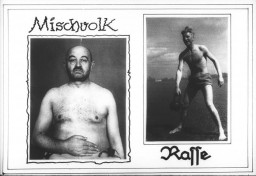
This image originates from a film produced by the Reich Propaganda Ministry. It is captioned: "A moral and religious conception of life demands the prevention of hereditarily ill offspring." Nazi propaganda aimed to create public support for the compulsory sterilization effort.
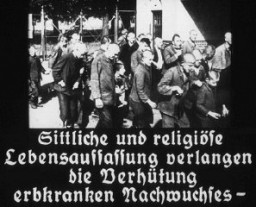
Propaganda slide for a Hitler Youth educational presentation entitled "German Achievements in the East." Circa 1934–1937.
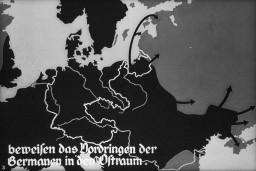
This image originates from a film produced by the Reich Propaganda Ministry. It shows patients in an unidentified asylum. Their existence is described as "life without hope." The Nazis sought, through propaganda, to develop public sympathy for the Euthanasia Program.
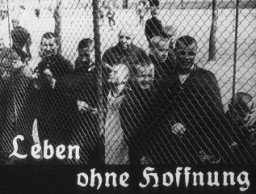
33rd Nazi propaganda slide of a Hitler Youth educational presentation entitled "Germany Overcomes Jewry." The text in German reads: "Zum Schutze des deutschen Blutes vor fremdrassiger Vermischung erliess der Fuhrer die." Translation: "For the protection of German blood against alien race mixing the Führer issued Nuremberg Laws."

Propaganda slide produced by the Reich Propaganda Office showing the opportunity cost of feeding a person with a hereditary disease. The illustration shows that an entire family of healthy Germans can live for one day on the same 5.50 Reichsmarks it costs to support one ill person for the same amount of time. Dated 1936. Nazis defined individuals with mental, physical, or social disabilities as “hereditarily ill” and claimed such individuals placed both a genetic and financial burden upon society…
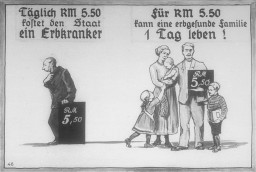
Property confiscated from deported Jews is stacked in a synagogue. Prague, Czechoslovakia, 1941–45.

Chief Prosecutor James M. McHaney during the Doctors' Trial. Nuremberg, Germany, December 9, 1946-August 20, 1947.

A protective pass issued by the Swiss consulate in Budapest, for Chief Rabbi Joseph Katona. Budapest, Hungary, October 23, 1944.
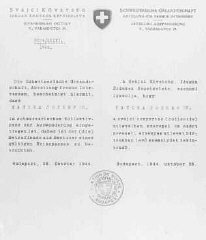
Jewish displaced persons protest Britain's decision to send back to Germany the Jewish refugees from the ship Exodus 1947. Photograph taken by Henry Ries. Hohne-Belsen displaced persons camp, Germany, September 1947.
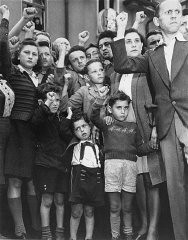
US Army and Joint Distribution Committee (JDC) representatives distribute milk to refugees. Vienna, Austria, October 26, 1945.
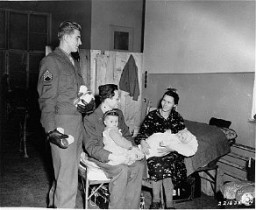
Harry Weinsaft of the American Jewish Joint Distribution Committee gives food to a young Jewish refugee. Vienna, Austria, postwar.
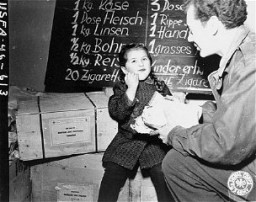
Lt. Col. J.W. Branch, Chief Surgeon of the 6th Armored Division, provides medical care to a Hungarian survivor in Penig, a subcamp of Buchenwald. Penig, Germany, April 26, 1945.
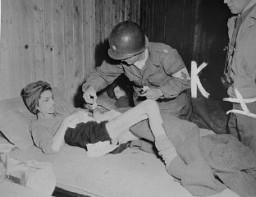
Public burning of "un-German" books in the Opernplatz (Opera Square). Berlin, Germany, May 10, 1933.
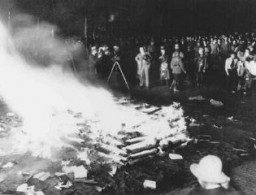
Public burning of "un-German" books in the Opernplatz (Opera Square) in Berlin. Students, some in SA uniform, march in a torchlight procession. Berlin, May 10, 1933.
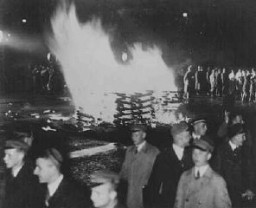
A group of young German boys view Der Stuermer, Die Woche, and other propaganda posters that are posted on a fence in Berlin, Germany, 1937.
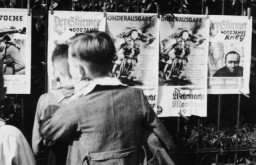
This photograph shows Julius Wolff, a young Jewish man, and Christine Neemann, his non-Jewish fiancé, standing between two police officers in Norden, Germany. Local SA men had accosted the couple and led them through the streets. The parade was meant to mock and humiliate the couple. Wolff wears a sign that reads: "I am a race defiler" ("Ich bin ein Rasseschänder"). Other photographs of this event show, and Neemann's testimony confirms, that Neemann was also forced to wear a sign. Neemann and Wolff…
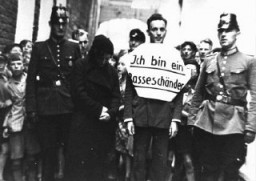
Two Jewish men (center, and at right in overcoat), carrying paint and brushes, who were forced by Austrian Nazis to paint "Jude" on the fronts of Jewish-owned businesses. Vienna, Austria, 1938.
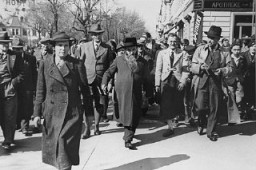
We would like to thank Crown Family Philanthropies, Abe and Ida Cooper Foundation, the Claims Conference, EVZ, and BMF for supporting the ongoing work to create content and resources for the Holocaust Encyclopedia. View the list of donor acknowledgement.